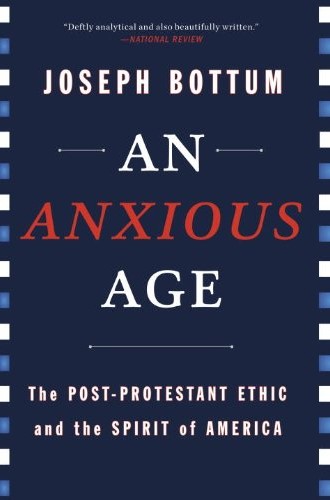An Anxious Age, by Joseph Bottum
According to Joseph Bottum, “the single most significant fact over the past few decades in America—the great explanatory event from which follows nearly everything in our social and political history—is the crumbling of the Mainline [Protestant] churches as central institutions in our national experience.”
Bottum, a practicing Catholic who has written widely and has worked on the staffs of both the Weekly Standard and First Things, contends that the failure of mainline churches, as shown by both their steadily declining membership and their lack of cultural influence, has created a moral vacuum in American life that the coalition of conservative Catholics and evangelicals has not been able to fill.
Read our latest issue or browse back issues.
Drawing on the metaphor of a three-legged stool, Bottum argues that the exceptionalism of American society has rested on democracy, capitalism, and religion. Each of these legs has provided both support for and pressure on the others, making possible a society of relative stability. Bottum begins with George Washington’s assertion that “reason and experience both forbid us to expect that national morality can prevail in exclusion of religious principle,” and argues that the dominant Protestant churches of the early republic commanded the implicit allegiance of a majority of Americans and provided the moral template for the nation. Now, he says, that template has crumbled.
Bottum is certainly not alone in describing the decline of mainline Protestantism in America. What makes his assessment unusual are three central claims.
First, he sees the problem not merely as a decline in numbers, but as the almost total destruction of mainline churches’ previous influence. Second, he attributes this decline to the triumph of the social gospel advocated by Walter Rauschenbusch, which, Bottum argues, made belief in the saving work of Jesus secondary to identification with certain social causes. Third, he contends that the new cultural “elites” are the spiritual descendants of the exhausted mainline, and that many of them never had any connection with traditional Protestantism.
He calls these elites Protestant Poster Children. They are spiritual but not religious people who have adopted the social gospel’s liberal social attitudes but discount or despise the religious roots of their culture. Whatever may have been their religious inheritance, they have distanced themselves from any faith, though they have retained what Bottum calls a Protestant assurance of the superiority of their attitudes. They have come to dominate the Democratic Party, the media, and major educational institutions. Those who have a living adherence to the substance of the faith—who “really believe it”—have gravitated to the Republican Party and other institutions where religious adherence is not despised.
As presented in this simple description, Bottum’s argument will appear to many readers as overstated if not totally false. Many of those who continue actively in mainline Protestantism vigorously assert their faith in the saving work of Jesus Christ. They do not consider themselves persons who have become detached from the roots of their faith and who are “thinning up like helium dissipating in the atmosphere.”
But, Bottum will counter, how many such mainline Protestants are there? Fewer than there used to be. Many of them are old, and many of their children do not share their faith. Mainline Protestantism, Bottum insists, constitutes a dying church. Its offspring may have inherited its sense of moral superiority, but they have not inherited its faith.
Bottum calls his extended essay a sociological treatise. He is more indebted to Max Weber, Robert Bellah, and Robert Putnam than to any theologian—except Walter Rauschenbusch. In A Theology for the Social Gospel, Rauschenbusch identified “six forces that joined to crucify Jesus.” They were “bigotry, the arrogance of power, the corruption of justice for personal ends, the madness of the mob, militarism, and class contempt.” According to Bottum, post-Protestants believe that “the best way to know themselves as moral is to define themselves in opposition to such bigotry and oppression. . . . Sin, in other words, appears as a social fact, and the redeemed personality becomes . . . confident of its own salvation by . . . knowing about, and rejecting, the evil that darkens society.”
If this is the essence of contemporary post-Protestant piety, there is no need for Jesus at all, and there is no need to be a Protestant. There is just the necessity of having the right attitude. And because all churches have been complicit in the sins that Rauschenbusch enumerated, the best way to be a Christian is to not be a Christian.
The second half of Bottum’s book explores what he regards as the failure of the American Catholic and evangelical coalition to fill the moral vacuum left by mainline Protestantism’s demise. Even though Catholics and evangelicals have gathered in opposition to abortion, and even though evangelicals have appropriated the language of Catholic natural law theology, their coalition has not won the battle against the elites. As a Catholic, Bottum laments this failure. He writes that like Catholics, evangelicals have always been outsiders, and their lack of intellectual and institutional resources continues to limit their influence.
The deep traditions and resources of Catholicism might have helped the coalition to succeed, he believes, had it not been for the essential foreignness of Catholicism to the American spirit and the devastating effects of the priestly sex scandals. Those scandals, following upon the follies of Vatican II, led to both the financial ruin of the Catholic Church in the United States and the loss of its moral authority. The result is that evangelicals and orthodox Catholics, despite their apparent ascension in the Republican Party, have been marginalized, while the post-Protestant elites (who once may have considered themselves Jews or Catholics) have come to a vapid but fierce dominance.
We are left with a society that is dangerously polarized, where people on each side see those on the other not as individuals who simply disagree, but as benighted or evil. In such a society, Bottum argues, the moral consensus that has supported American democracy and capitalism and restrained their excesses is in danger.
Bottum’s book is intriguing but frustrating. He gives no attention to poor people. He disregards black churches. His regard for evangelicals is almost insulting. Yet despite all this, he accurately describes the cultures I have worked in at Bates and Dartmouth colleges. Part of the reason for religious disaffection is that the media now apply the word Christian only to conservative evangelicals and Catholics. Apparently they cannot locate any other Christian demographic. My students have pretty much concluded that if those are the Christians, they don’t want anything to do with them. And Bottum is right that mainline Protestants have not offered a compelling alternative vision.
Perhaps Pope Francis can change the popular perception of Christianity. Meanwhile, Bottum’s description of the people who think they are saved as long as they have the right positions on social questions is more accurate than not.






